- Courses
- GS Full Course 1 Year
- GS Full Course 2 Year
- GS Full Course 3 Year
- GS Full Course Till Selection
- Answer Alpha: Mains 2025 Mentorship
- MEP (Mains Enrichment Programme) Data, Facts
- Essay Target – 150+ Marks
- Online Program
- GS Recorded Course
- Polity
- Geography
- Economy
- Ancient, Medieval and Art & Culture AMAC
- Modern India, Post Independence & World History
- Environment
- Governance
- Science & Technology
- International Relations and Internal Security
- Disaster Management
- Ethics
- NCERT Current Affairs
- Indian Society and Social Issue
- NCERT- Science and Technology
- NCERT - Geography
- NCERT - Ancient History
- NCERT- World History
- NCERT Modern History
- CSAT
- 5 LAYERED ARJUNA Mentorship
- Public Administration Optional
- ABOUT US
- OUR TOPPERS
- TEST SERIES
- FREE STUDY MATERIAL
- VIDEOS
- CONTACT US
PLACES IN NEWS 18 NOVEMBER 2024
PLACES IN NEWS 18 NOVEMBER 2024
Panna Tiger Reserve (PTR)
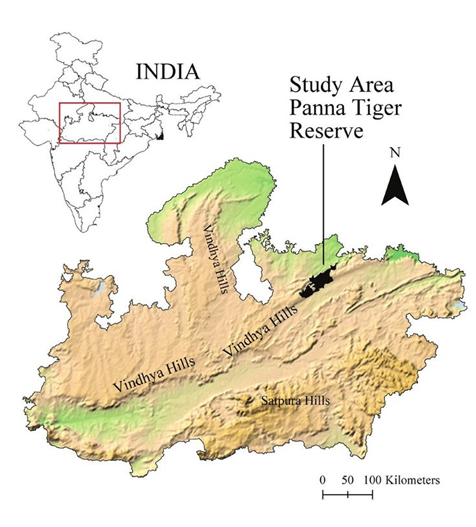
- In November 2024, A mass vaccination of stray dogs was started to prevent the spread of canine distemper virus (CDV) that could threaten wildlife in the reserve.
- Panna Tiger Reserve, located in the Vindhyan mountain range of northern Madhya Pradesh, covers an area of 542 sq.km.
- It is the only Tiger Reserve in the Bundelkhand region and was declared a Project Tiger Reserve in 1994.
Geography:
- The reserve features a "Table Top" topography with plateaus and gorges.
- The Ken River flows through the reserve from south to north.
- It is home to 2,000-year-old rock paintings.
Flora:
- The reserve's vegetation consists mainly of dry deciduous forests, with grasslands interspersed.
- Teak forests surround the north, while mixed Teak-Kardhai forests border the east.
- Acacia catachu thrives on steep slopes.
Fauna:
- Panna supports a diverse range of animals, including tigers, sloth bears, leopards, and striped hyenas.
- Other carnivores include jackals, wolves, wild dogs, jungle cats, and rusty-spotted cats.
- The Vindhya Hill ranges connect wild animal populations across the region.
Key Facts about Canine Distemper:
- Cause: Canine distemper is a contagious and serious disease caused by the canine distemper virus (CDV).
- Impact on Health: The virus attacks the respiratory, gastrointestinal, and nervous systems of affected animals.
- At-Risk Groups: All dogs are vulnerable to CDV, especially puppies under four months and unvaccinated dogs. It can also infect ferrets and other mammals, particularly carnivores.
- Transmission: The virus spreads mainly through aerosol droplets from infected animals, and some infected dogs can shed virus particles for months.
- Symptoms: Common symptoms include coughing, fever, and discharge from the eyes and/or nose.
- Treatment: There is no cure for canine distemper, and no antiviral drugs are available. Vaccination is the most effective prevention.
Senna tora Plant:
In November 2024, The Tamil Nadu Forest Department is addressing the spread of Senna tora, a potentially invasive plant species, in parts of the Mudumalai Tiger Reserve (MTR).
About Senna tora Plant:
- Origin: Native to Central America.
- Habitat: A plant that can be annual, perennial, or subshrub, Senna tora primarily grows in wet tropical environments. It is now emerging in drier areas of India, germinating after the southwest monsoon and withering by year-end.
- Uses: It has various applications, including as animal food, a poison, a medicinal herb, and for environmental purposes.
Key Facts about Mudumalai Tiger Reserve (MTR):
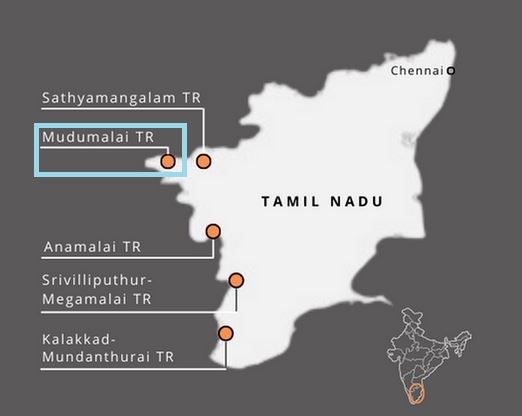
- Location: Situated in the Nilgiris District of Tamil Nadu, MTR lies at the confluence of three states—Tamil Nadu, Karnataka, and Kerala.
- Historical Significance: The name Mudumalai means "ancient hill range," referring to the reserve's 65-million-year-old history, linked to the formation of the Western Ghats.
- Neighboring Reserves: MTR shares boundaries with Wayanad Wildlife Sanctuary (Kerala) to the west and Bandipur Tiger Reserve (Karnataka) to the north.
- Tourism: The Theppakadu elephant camp is a notable tourist attraction in the reserve.
- Vegetation: The reserve features diverse habitats, including tropical evergreen forests, moist and dry deciduous forests, teak forests, secondary grasslands, and swamps.
- Flora: Notable plants include tall grasses known as "Elephant Grass," giant bamboo, and valuable timber species such as teak and rosewood.
- Fauna: MTR is home to a variety of wildlife, including elephants, tigers, panthers, gaur, spotted deer, barking deer, wild boars, and porcupines.
Red-Headed Vulture: Critically Endangered: Manhampothikunnu near Mavungal in Kasaragod, Kerala
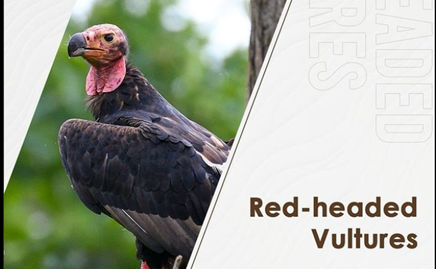
In November 2024, A Red-Headed Vulture was sighted for the first time at Manhampothikunnu near Mavungal in Kasaragod, Kerala.
About the Red-Headed Vulture:
- Other Names: Also known as the Asian King Vulture or Pondicherry Vulture.
- Appearance: This dark, medium-sized vulture has a bare reddish head and loose neck flaps. It weighs around 5 kg and measures over 80 cm in length. Its black plumage has a distinct white patch on the abdomen, which becomes more noticeable during flight. It is typically seen alone or with a mate.
- Distribution: Found in Central India, Nepal, Myanmar, Thailand, Vietnam, and parts of Kerala, Karnataka, and Tamil Nadu.
- Breeding: Breeding occurs between November and January.
Conservation Status:
- IUCN Red List: Critically Endangered
- Wildlife Protection Act, 1972: Listed under Schedule 1.
- Threat: Once abundant in India, the vulture's numbers drastically declined due to diclofenac poisoning, a veterinary drug harmful to vultures.
Bodoland Mahotsav:
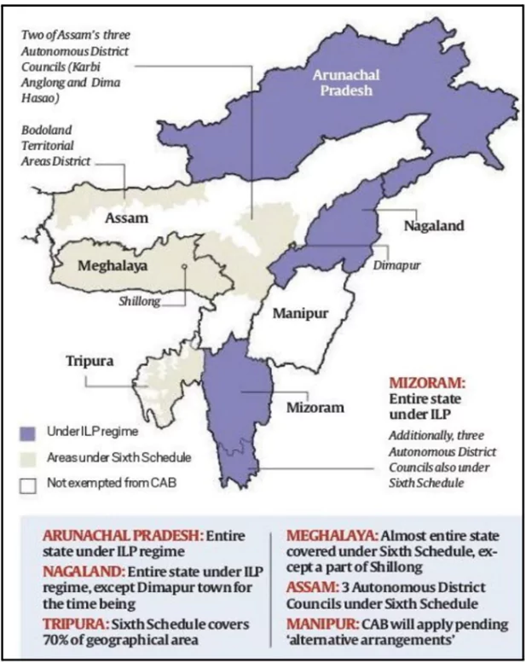
In November 2024, The Prime Minister inaugurated the 1st Bodoland Mahotsav in New Delhi.
About Bodoland Mahotsav:
- Purpose: The Mahotsav is a major cultural event focused on language, literature, and culture to promote peace and build a Vibrant Bodo Society.
- Theme: "Peace and Harmony for Prosperous Bharat," emphasizing the rich culture, language, and education of the Bodo community, alongside other communities from the Bodoland Territorial Region.
- Objectives: It aims to highlight the cultural and linguistic heritage, ecological biodiversity, and tourism potential of Bodoland, while also celebrating the progress made since the signing of the Bodo Peace Accord in 2020.
Key Facts about the Bodo Tribe:
- Historical Significance: The Bodos are one of the earliest known ethnic groups in Assam, historically part of Pragjyotishpur and Kamrupa. They belong to the Mongoloid stock of the Indo-Mongoloid or Indo-Tibetan group.
- Linguistic Traits: The Bodo people speak Tibeto-Burman languages and are found in North and East Bengal, Assam, and Burma.
- Regional Names: In Assam's Brahmaputra Valley, they are known as Bodos or Boros, while in Lower Assam, West Bengal, and Nepal, they are called Meches.
Lake Kariba
A severe drought has caused Lake Kariba to reach near-record low water levels, threatening the operation of the Kariba Dam, which powers the economies of Zambia and Zimbabwe. This could mark the first shutdown in the dam’s 65-year history.
About Lake Kariba:
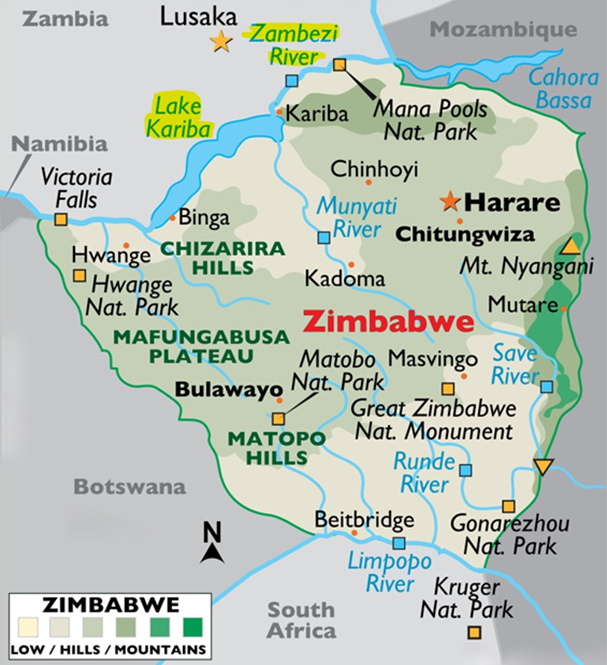
- Location: Lake Kariba is situated in central Africa, along the border between Zambia and Zimbabwe. It is positioned 810 miles upstream from the Indian Ocean.
- Size: It is the world’s largest man-made lake, covering 2,000 square miles (5,200 square km).
- Formation: The lake was created by damming the Zambezi River in the Kariba Gorge, located 250 miles (400 km) below Victoria Falls.
- Kariba Dam: The dam features a double-arch wall and is 128 meters tall, 617 meters long, 13 meters wide at the top, and 24 meters wide at the base.
- Importance: The lake supplies significant electric power to both Zambia and Zimbabwe and supports a thriving commercial fishing industry.
- Islands: The lake has 102 islands, including Chete Island and Spurwing Island.
- Chete Island is notable for its protected wetlands and hosts the world’s largest population of African elephants.
PM Modi receives Nigeria's second-highest national award
In November, 2024, Prime Minister Narendra Modi was honoured with Nigeria's prestigious "Grand Commander of the Order of the Niger" (GCON) award during his visit to the country.
More about news:
- This makes him only the second foreign dignitary to receive this award, the first being Queen Elizabeth II in 1969.
- The award is a symbol of Nigeria's recognition of global leaders who significantly contribute to strengthening bilateral and international relations.
About Nigeria
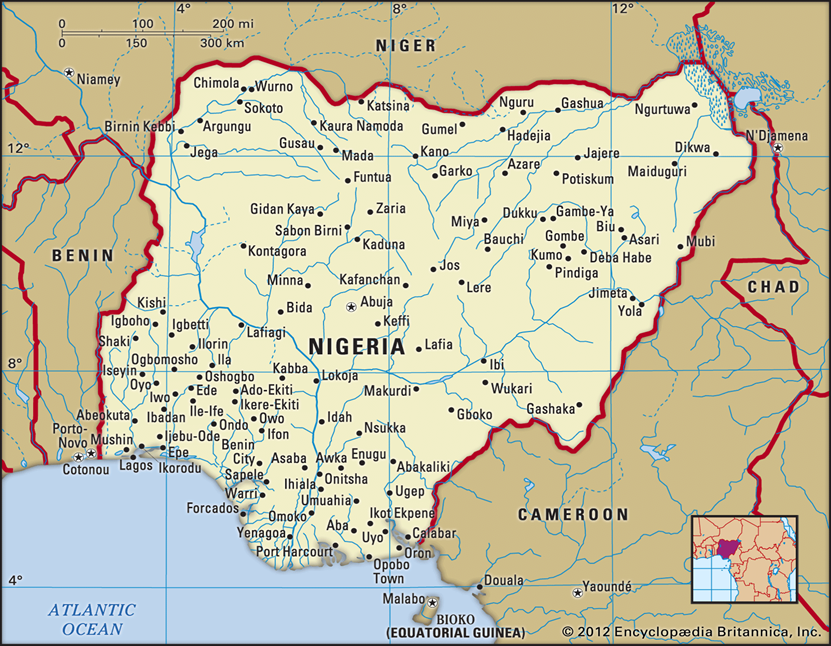
- Nigeria, officially the Federal Republic of Nigeria (Capital city is Abuja), is a country in West Africa. It lies between the Sahel to the north and the Gulf of Guinea to the south, on the Atlantic Ocean.
- Area: Nigeria spans approximately 923,768 square kilometres, making it the 14th largest country in Africa.
- Population: With over 220 million people, Nigeria is Africa's most populous nation.
- Bordering Countries: Nigeria shares borders with Benin to the west, Niger to the north, Chad to the northeast, and Cameroon to the east. It also has a southern coastline along the Gulf of Guinea.
- Political Structure: Nigeria operates as a federal presidential republic, with the president serving as both the head of state and government.
- Agriculture:
- Nigeria is the largest producer of cassava in the world, contributing significantly to the global supply of this root crop.
- It is also one of the top producers of palm oil, groundnut, and cocoa.
- Mineral Resources:
- Rich in oil and natural gas, Nigeria is a leading oil producer in Africa.
- It also has abundant resources of coal, tin, limestone, lead, zinc, and iron ore.
Centre reimposes AFSPA in six police station limits in Manipur
The Armed Forces (Special Powers) Act (AFSPA) has recently been reimposed in certain areas of Manipur due to ongoing ethnic violence and insurgent activity.
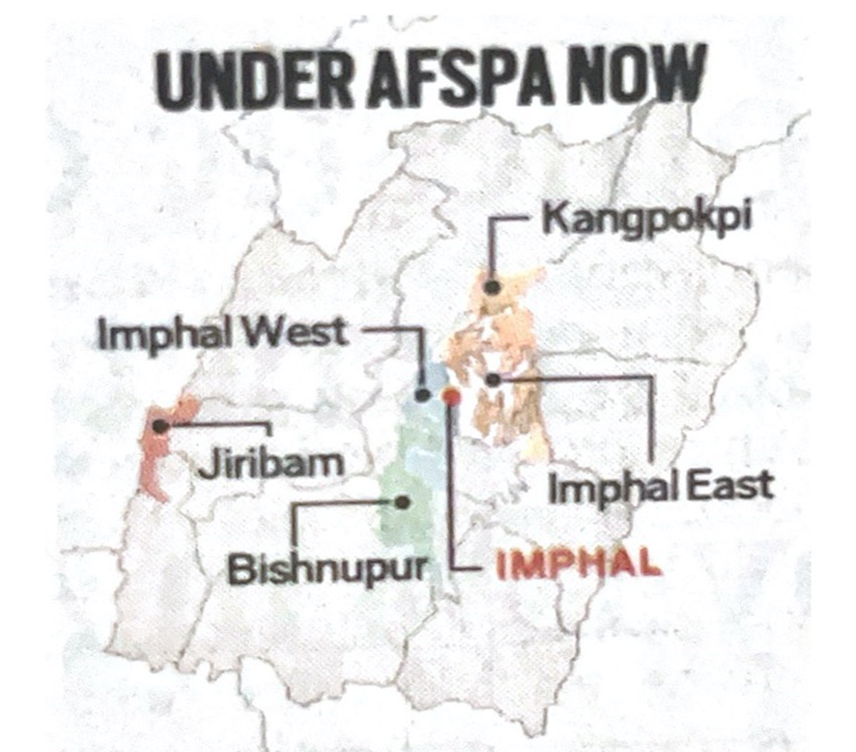
More about News:
- The Union Ministry of Home Affairs declared six police station jurisdictions as "disturbed areas," bringing them under AFSPA.
- These include Sekmai and Lamsang in Imphal West, Lamlai in Imphal East, Moirang in Bishnupur, Leimakhong in Kangpokpi, and Jiribam.
- This decision reverses previous reductions in AFSPA-covered areas made in 2022 and 2023 as the violence escalated in the state.
About Manipur
- Manipur is a state in northeast India, with Imphal as its capital.
- The state spans an area of 22,327 square kilometres (8,621 square miles).
- The official language is Meitei (officially called Manipuri), which is native to the Meitei people and serves as a lingua franca for various smaller communities speaking Tibeto-Burman languages.
- Biodiversity:
- Manipur is part of the Indo-Burma biodiversity hotspot, known for its rich flora and fauna. It is home to unique species such as the Sangai deer and brow-antlered deer.
- Major protected areas include:
- Keibul Lamjao National Park: The only floating national park in the world known as Phumdis, located on Loktak Lake.
- Yangoupokpi-Lokchao Wildlife Sanctuary: Known for its rare and endangered species.
- State Bird and Animal:
- State Bird: Nongin (Blyth’s Tragopan)
- State Animal: Sangai (Brow-antlered deer), an endangered species found exclusively in Keibul Lamjao National Park.
- Connectivity:
- Roads: Manipur is connected to the rest of India through National Highway 39 and other major roadways.
- Air: The Imphal International Airport connects the state to major Indian cities and nearby countries.
- Railways: The Jiribam-Imphal railway line is under development to improve connectivity.
- Forest Cover:
- Approximately 75% of Manipur’s area is covered by forests, featuring tropical and subtropical vegetation.
- Dense forests are rich in timber and non-timber products like bamboo and cane.
New Zealand Lawmakers staged “Haka” Against Divisive bill.

Member of Parliament Hana-Rawhiti Maipi-Clarke led the ceremonial performance of Māori culture, tearing up a controversial bill
On November 14, 2024, Māori lawmakers in New Zealand disrupted a parliamentary session by performing the haka, a traditional ceremonial dance.
More about news:
- This dramatic protest was against a bill proposed by the ACT New Zealand party, which seeks to reinterpret the Treaty of Waitangi—New Zealand's foundational agreement from 1840 between the British Crown and Māori chiefs.
- Critics argue the bill would undermine Indigenous rights by diluting provisions specific to Māori, extending them universally to all citizens.
- The protest highlighted concerns over the erosion of Māori cultural and land rights, with opposition echoed in a large-scale march towards the capital, Wellington.
About Māori Tribe:
- Origins and Population: Māori are the Indigenous Polynesian people of New Zealand, making up approximately 20% of the country's population of 5.3 million.
- Language: Their native language, Te Reo Māori, is an official language of New Zealand.
- Culture: The haka is a vital cultural practice, originally a war dance but now performed during ceremonies, celebrations, and protests.
- Treaty of Waitangi: Signed in 1840, this treaty aimed to protect Māori lands and rights but has been a source of contention due to differing interpretations and historical breaches.
- Connection to Land: The Māori have a deep spiritual relationship with the land (whenua), considering it an ancestral legacy that connects them to their heritage.
Must Check: Best IAS Coaching In Delhi
UPSC Prelims Result 2024 Out: Expected Cut Off & Other Details, UPSC Prelims 2024 Answer with Explanation, Daily Prelims Quiz, Daily Current Affairs, MONTHLY CURRENT AFFAIRS TOTAL (CAT) MAGAZINE, Best IAS Coaching Institute in Karol Bagh, Best IAS Coaching Institute in Delhi, Daily Mains Question Answer Practice, ENSURE IAS UPSC Toppers, UPSC Toppers Marksheet, Previous Year Interview Questions, UPSC Syllabus




